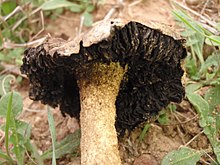Montagnea arenaria
| Montagnea arenaria | |
|---|---|

| |
| Scientific classification | |
| Domain: | Eukaryota |
| Kingdom: | Fungi |
| Division: | Basidiomycota |
| Class: | Agaricomycetes |
| Order: | Agaricales |
| Family: | Agaricaceae |
| Genus: | Montagnea |
| Species: | M. arenaria |
| Binomial name | |
| Montagnea arenaria | |
| Synonyms[1] | |
|
Agaricus arenarius DC. (1815) | |
| Montagnea arenaria | |
|---|---|
| Gills on hymenium | |
| Cap is flat | |
| Hymenium attachment is irregular or not applicable | |
| Stipe has a volva | |
| Edibility is inedible | |
Montagnea arenaria, commonly known as the gasteroid coprinus,[2] is a species of secotioid fungus in the family Agaricaceae. Originally named Agaricus arenarius by Augustin Pyramus de Candolle in 1815,[3] it was transferred to the genus Montagnea by Sanford Myron Zeller in 1943. The species is characterized by a cap that has an apical disc, radial gills, a hymenophore, and spores with a prominent germ pore.[4] It is inedible.[5]
References
- ^ "Montagnea arenaria (DC.) Zeller 1943". MycoBank. International Mycological Association. Retrieved 2011-03-22.
- ^ Arora, David (1986). Mushrooms demystified: a comprehensive guide to the fleshy fungi (Second ed.). Berkeley: Ten Speed Press. ISBN 978-0-89815-169-5.
- ^ De Candolle AP. (1815). Flore française (in French). Vol. 6 (3 ed.). p. 15.
- ^ Zeller, S. M. (1943). "North American species of Galeropsis, Gyrophagmium, Longia, and Montagnea". Mycologia. 35 (4): 409–21. doi:10.2307/3754593. JSTOR 3754593.
- ^ Miller Jr., Orson K.; Miller, Hope H. (2006). North American Mushrooms: A Field Guide to Edible and Inedible Fungi. Guilford, CN: FalconGuides. p. 490. ISBN 978-0-7627-3109-1.
External links
